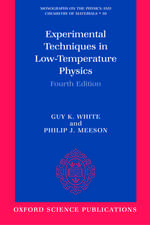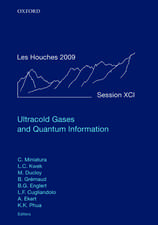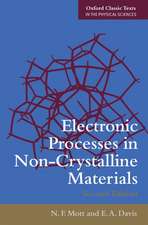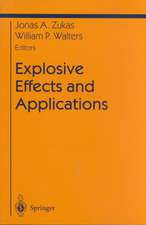Organic Molecular Crystals: Their Electronic States: Springer Series in Solid-State Sciences, cartea 16
Autor Edgar A. Silinsh Traducere de J. Eidussen Limba Engleză Paperback – 12 feb 2012
Din seria Springer Series in Solid-State Sciences
- 18%
 Preț: 1225.94 lei
Preț: 1225.94 lei - 18%
 Preț: 1017.62 lei
Preț: 1017.62 lei - 15%
 Preț: 532.05 lei
Preț: 532.05 lei - 18%
 Preț: 944.51 lei
Preț: 944.51 lei -
 Preț: 541.46 lei
Preț: 541.46 lei - 18%
 Preț: 956.96 lei
Preț: 956.96 lei -
 Preț: 385.84 lei
Preț: 385.84 lei - 18%
 Preț: 1827.48 lei
Preț: 1827.48 lei - 15%
 Preț: 661.02 lei
Preț: 661.02 lei -
 Preț: 389.88 lei
Preț: 389.88 lei - 15%
 Preț: 639.59 lei
Preț: 639.59 lei - 15%
 Preț: 635.15 lei
Preț: 635.15 lei - 18%
 Preț: 896.21 lei
Preț: 896.21 lei - 15%
 Preț: 647.92 lei
Preț: 647.92 lei - 15%
 Preț: 651.34 lei
Preț: 651.34 lei - 18%
 Preț: 890.23 lei
Preț: 890.23 lei - 15%
 Preț: 640.55 lei
Preț: 640.55 lei - 15%
 Preț: 649.54 lei
Preț: 649.54 lei - 15%
 Preț: 645.60 lei
Preț: 645.60 lei - 15%
 Preț: 644.30 lei
Preț: 644.30 lei - 15%
 Preț: 653.79 lei
Preț: 653.79 lei - 18%
 Preț: 956.69 lei
Preț: 956.69 lei - 15%
 Preț: 637.59 lei
Preț: 637.59 lei - 23%
 Preț: 1043.41 lei
Preț: 1043.41 lei - 15%
 Preț: 639.08 lei
Preț: 639.08 lei - 15%
 Preț: 648.24 lei
Preț: 648.24 lei - 15%
 Preț: 637.46 lei
Preț: 637.46 lei - 15%
 Preț: 640.06 lei
Preț: 640.06 lei -
 Preț: 391.40 lei
Preț: 391.40 lei -
 Preț: 390.84 lei
Preț: 390.84 lei - 15%
 Preț: 638.57 lei
Preț: 638.57 lei - 18%
 Preț: 1006.06 lei
Preț: 1006.06 lei - 18%
 Preț: 730.79 lei
Preț: 730.79 lei - 15%
 Preț: 640.37 lei
Preț: 640.37 lei - 15%
 Preț: 643.65 lei
Preț: 643.65 lei - 18%
 Preț: 1231.01 lei
Preț: 1231.01 lei - 18%
 Preț: 950.21 lei
Preț: 950.21 lei - 15%
 Preț: 642.68 lei
Preț: 642.68 lei - 15%
 Preț: 640.55 lei
Preț: 640.55 lei - 18%
 Preț: 1229.10 lei
Preț: 1229.10 lei
Preț: 394.87 lei
Nou
Puncte Express: 592
Preț estimativ în valută:
75.56€ • 79.15$ • 62.62£
75.56€ • 79.15$ • 62.62£
Carte tipărită la comandă
Livrare economică 08-22 aprilie
Preluare comenzi: 021 569.72.76
Specificații
ISBN-13: 9783642814662
ISBN-10: 3642814662
Pagini: 412
Ilustrații: XVIII, 392 p. 11 illus.
Dimensiuni: 155 x 235 x 22 mm
Greutate: 0.58 kg
Ediția:Softcover reprint of the original 1st ed. 1980
Editura: Springer Berlin, Heidelberg
Colecția Springer
Seria Springer Series in Solid-State Sciences
Locul publicării:Berlin, Heidelberg, Germany
ISBN-10: 3642814662
Pagini: 412
Ilustrații: XVIII, 392 p. 11 illus.
Dimensiuni: 155 x 235 x 22 mm
Greutate: 0.58 kg
Ediția:Softcover reprint of the original 1st ed. 1980
Editura: Springer Berlin, Heidelberg
Colecția Springer
Seria Springer Series in Solid-State Sciences
Locul publicării:Berlin, Heidelberg, Germany
Public țintă
ResearchCuprins
1. Introduction: Characteristic Features of Organic Molecular Crystals.- 1.1 Interaction Forces in Molecular Crystals.- 1.2 The Atom-Atom Potential Method.- 1.3 Aromatic Hydrocarbons — Model Compounds of Organic Molecular Crystals.- 1.4 Specific Properties of Electronic States in a Molecular Crystal.- 1.5 Basic Characteristics of Electronic Conduction States in Molecular Crystals.- 2. Electronic States of an Ideal Molecular Crystal.- 2.1 Neutral Excited States in a Molecular Crystal.- 2.2 Ionized States in a Molecular Crystal.- 2.3 Electronic Polarization of a Molecular Crystal by a Charge Carrier.- 2.4 Electrostatic Methods of Electronic Polarization Energy Calculation in Molecular Crystals.- 2.5 Determination of Molecular Polarizability Tensor.- 2.6 Selection of Molecular Polarizability Components bi. for Electronic Polarization Energy Calculations.- 2.7 Extended Polarization Model of Ionized States in Molecular Crystal s.- 2.8 Charge Transfer (CT) States in Molecular Crystals.- 2.9 Experimental Determination of Energy Structure Parameters in Molecular Crystals.- 2.10 Energy Structure of an Anthracene Crystal.- 2.11 Energy Structure of Aromatic and Heterocyclic Molecular Crystals.- 3. Role of Structural Defects in the Formation of Local Electronic States in Molecular Crystals.- 3.1 Statistical Aspects of the Formation of Local States of Polarization Origin.- 3.2 General Considerations on the Role of Specific Structural Defects.- 3.3 Point Defects (Vacancies) in Molecular Crystals, Their Crystallographic and Electronic Properties.- 3.4 Dislocation Defects, Their Role in Local State Formation.- 3.5 Energetics of Dislocations in Molecular Crystals.- 3.6 Atomic and Molecular Models of the Dislocation Core.- 3.7 Dislocation Alignments and Aggregations, TheirConfigurational and Energetic Properties.- 3.8 Grain Boundaries, Their Energetic Characteristics.- 3.9 Stacking Faults in Molecular Crystals.- 3.10 Formation of Predimer States in the Regions of Extended Structural Defects of Anthracene-Type Crystals.- 3.11 Some More Complex Two- and Three-Dimensional Lattice Defects in Molecular Crystals.- 3.12 Observation of Structural Defects in Molecular Crystals.- 3.13 Main Characteristics of Dislocation Defects in Some Model Molecular Crystals.- 4. Local Trapping Centers for Excitons in Molecular Crystals.- 4.1 Theory of Exciton States in a Deformed Molecular Crystal.- 4.2 Electron Level Shifts in Hydrostatically Compressed Molecular Crystal s.- 4.3 Formation of Local Exciton Trapping Centers in Structural Defects of a Crystal.- 5. Local Trapping States for Charge Carriers in Molecular Crystals.- 5.1 Electronic Polarization Energy of a Compressed Anthracene Crystal.- 5.2 Formation of Local Trapping Centers for Charge Carriers in Structural Defects of a Real Molecular Crystal.- 5.3 Energy Spectrum of Local States of Polarization Origin in Stacking Faults of an Anthracene Crystal.- 5.4 Local Surface States of Polarization Origin in Molecular Crystals.- 5.5 Local States of Polarization Origin in the Vicinity of a Lattice Vacancy.- 5.6 Local Charge Carrier Trapping in Covalent, Ionic and Molecular Crystal s.- 5.7 Randomizing Factors Determining Gaussian Distribution of Local States of Structural Origin.- 5.8 Investigation of Local Trapping States by Method of Space Charge Limited Currents (SCLC).- 5.9 Phenomenological SCLC Theory for Molecular Crystals with Gaussian Distribution of Local Trapping States.- 5.10 Gaussian SCLC Approximations of Experimental CV Characteristics.- 5.11 SCLC Theory for Spatially Nonuniform Trap Distribution.- 5.12 Investigation of Local Trapping States by Thermally Activated Spectroscopy Techniques.- 5.13 Other Experimental Methods for Local Trapping State Study.- 5.14 Correlations Between Distribution Parameters of Local Trapping States and Crystalline Structure.- 5.15 Local Lattice Polarization by Trapped Charge Carrier in Molecular Crystals.- 5.16 Guest Molecules as Trapping Centers in a Host Lattice.- 6. Summing Up and Looking Ahead.- References.- Additional References with Titles.
















